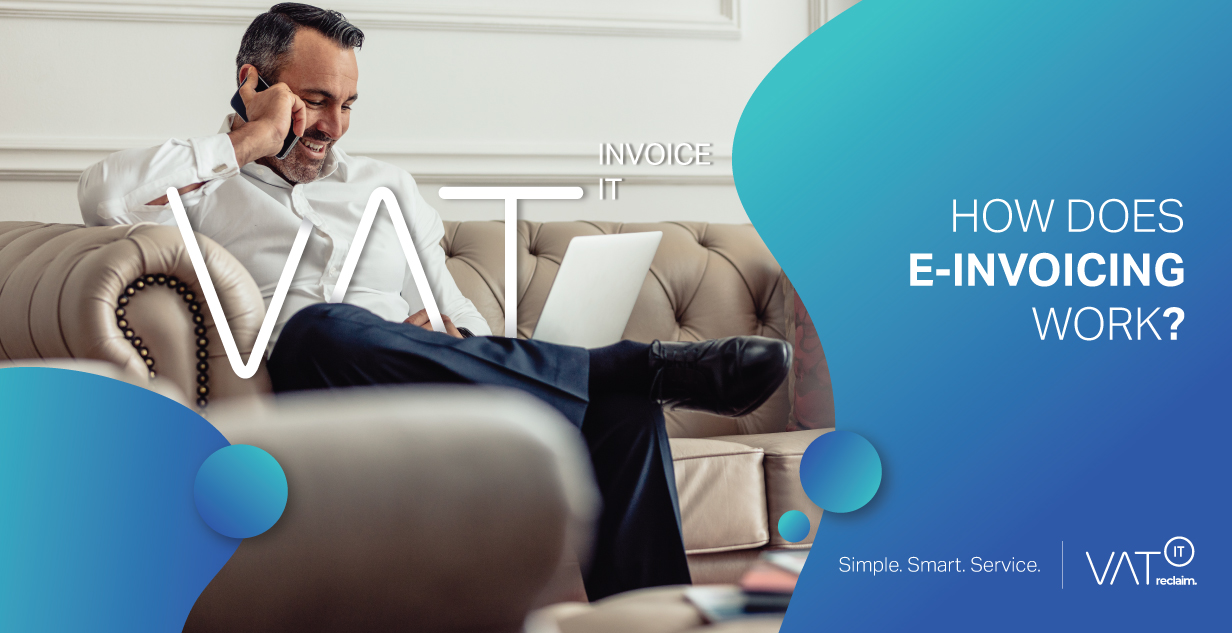How does e-invoicing work?
E-invoicing is a more efficient, accurate and cost-effective way for businesses to manage their invoicing and comply with VAT obligations. At least, it can be. Real-world studies show that companies benefit from e-invoicing when they have the right...

E-invoicing is a more efficient, accurate and cost-effective way for businesses to manage their invoicing and comply with VAT obligations. At least, it can be. Real-world studies show that companies benefit from e-invoicing when they have the right technology and systems in place, like accounting software. E-invoicing works the same as regular paper invoicing in delivering digital invoice data.
What is the difference between invoice and e-invoice?
An e-invoice is an electronic invoice that follows a specific invoice data structure. E-invoicing describes a complete system of record-keeping and invoice submission. An e-invoice is not a paper invoice that has been digitised (e.g. a scanned paper document or PDF). Nor are they simply any document in electronic form.
There is both a specified way in which e-invoices must be structured, and there are rules about how e-invoices are transmitted. Often, the local regulations will specify that e-invoicing must follow a widely-recognised standard, such as PEPPOL.
E-invoicing compliance requires implementing a system to both create and exchange invoices according to the local e-invoicing regulations. Businesses generally are also obliged to store e-invoices for a specified amount of time.
How do I create an electronic invoice?
Like a paper invoicing process, the e-invoicing process requires specific compliance. Electronic invoices should be automatically issued by the company’s ERP. In order to effectively create electronic invoices, a business needs to ensure that it has appropriate software. The technology also needs to be configured to meet the specific format required by local authorities. Correctly structured invoice data is an important aspect of e-invoices.
Businesses that use e-invoices also need to be able to transmit and receive e-invoices to and from other businesses.
When an e-invoicing system is properly configured, the ERP both produces and transmits the electronic invoice to the proper recipient.
Electronic invoices must be machine-readable, according to the agreed standards, and must be created in the appropriate format (such as XML, where indicated).
How are electronic invoices shared?
International e-invoicing standards, such as PEPPOL, make transmitting e-invoices between companies simpler and more cost-effective.
Using a PEPPOL Access Point, a company connects to the PEPPOL network. Doing so enables the company to easily share invoices with other businesses connected to the network.
PEPPOL is currently used in a number of countries in the European Union. It was also adopted by authorities in Singapore.
When must a business issue e-invoices?
Electronic invoices are a central part of the move towards digital VAT compliance. Tax authorities around the world increasingly favour electronic standards, including e-invoicing and digital VAT returns.
It is not surprising, therefore, that e-invoicing is now mandatory in many countries.
Given the complexity of introducing e-invoicing, especially for small businesses, many governments have taken a phased approach to rolling out mandatory e-invoicing. For example, by initially making e-invoicing obligatory for transactions between business and government, followed by mandatory B2B e-invoicing for large firms, and finally a universal e-invoicing requirement.
Understanding your e-invoicing obligations can be complex, especially if your business issues invoices in more than one country. There is no universal framework for creating and issuing e-invoices. Each country devises its own specific rules. And where e-invoicing is mandatory, it may not yet apply to all businesses.
Businesses with global VAT obligations should therefore seek expert advice if they are unsure of their obligations in every jurisdiction. Failure to comply with the specified local e-invoicing format could result in serious penalties. Because it's critical to remain in compliance, it's important for every business to check their government agency regulations.
Which companies issue e-invoices?
Generally, e-invoicing applies to transactions between businesses (or between businesses and government entities). Under current rules, businesses generally do not have to issue e-invoices in the case of B2C transactions, mainly B2B transactions.
As discussed above, many countries follow a phased approach to mandatory e-invoicing. The timelines are different in each country. However, as a rule of thumb, B2B transactions between large firms are most likely to be subject to mandatory e-invoicing at the present time.
However, smaller businesses may still be able to join e-invoicing programmes even if they are not yet obliged to do so.
How does an e-invoice help VAT?
In many countries, e-invoicing forms part of a broader move towards electronic VAT compliance. If you do not issue electronic invoices in the prescribed format, according to local regulations, you could be in breach of VAT rules.
Electronic invoicing produces a clear, immutable digital record of transactions between businesses. E-invoicing, therefore, enhances VAT compliance by making VAT avoidance much harder to achieve.
In addition to e-invoicing, many countries are introducing advanced digital reporting requirements. For example, real time reporting is becoming an increasingly popular policy option.
In order to ensure full VAT compliance, businesses need flexible software that ensures that they effectively meet all current and future electronic VAT reporting requirements.
Are there business benefits to electronic invoices?
In many cases, businesses are switching to electronic invoicing because of legal requirements. However, e-invoices also offer a number of business benefits, provided the right technology is in place.
As electronic invoicing is automated, it’s faster, more efficient and accurate. It’s also much easier to track all invoices, giving managers actionable insights about cash flow and other financial metrics. E-invoices are also more secure and easy to store.
Importantly, automation frees up your finance team, so they don’t have to waste countless hours on menial administrative tasks.
What are the risks of issuing e-invoices?
As e-invoicing is an automated process, your invoicing systems need to be set up correctly. Poorly configured e-invoicing could lead to incorrect financial data at scale and put your business at risk of breaching invoicing regulations.
Bear in mind that real time reporting and electronic invoicing also make company data more transparent to tax authorities. Any irregularities or noncompliance issues are likely to be detected and penalised. So, it's critical to ensure your e-invoice processing system is set up correctly.
Staying ahead of global e-invoicing requirements
E-invoicing is one component of a business’s compliance obligations. In order to get the most out of your e-invoicing system, it is often useful to take a careful assessment of all invoicing, reporting and filing obligations.
Ideally, you need an integrated e-invoicing compliance solution that ensures all filing, record-keeping and compliance tasks are performed efficiently, seamlessly and correctly.
As the world’s leading VAT compliance and recovery specialists, VAT IT provides the advanced technology and support companies need to optimise VAT compliance and adapt as regulations change.
Our VAT software makes reporting simple. You get in-depth expense analysis at the touch of a button. And our machine learning OCR platform eliminates human error, ensuring speed and accuracy.
Get in touch with VAT IT to secure 100% VAT compliance, in every country in which you have VAT and invoicing obligations.
Related blogs
VAT refund Tool kit
Contact Us
Come explore your refund possibilities.
Chat with us today.
Find out how you could turn company spend into income




